Excerpts from Jim Conrad's
Naturalist Newsletter
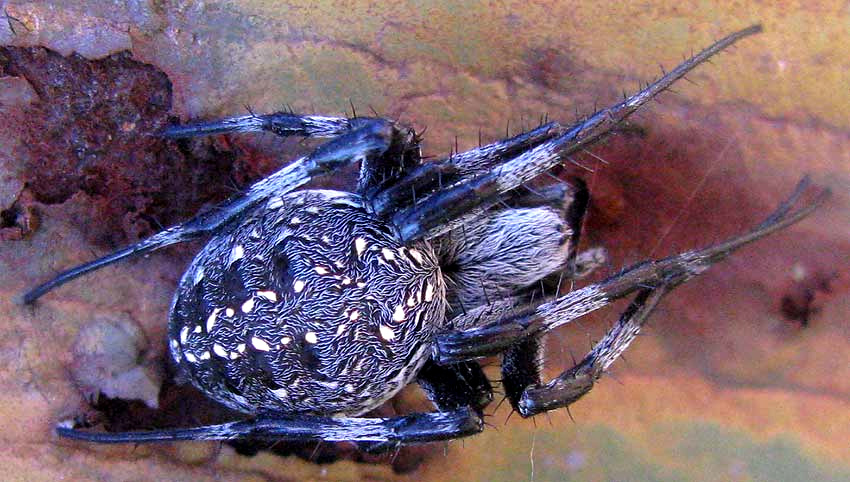
from the September 16, 2012 Newsletter issued from the Frio Canyon Nature Education Center in the valley of the Dry Frio River in northern Uvalde County, southwestern Texas, on the southern border of the Edwards Plateau; elevation ~1750m (~5750 ft); N29.62°, W99.86°; USA
WESTERN SPOTTED ORBWEAVER
On a typically hot, windy, sun-baked afternoon while beating stone-hard clods into dust in a spot where eventually I wanted to sow a winter crop of turnips I noticed a slight commotion between wires atop the deer-fence. It was a medium-sized, dark spider wrapping something in silk. You can see her and her silk-tied package below.
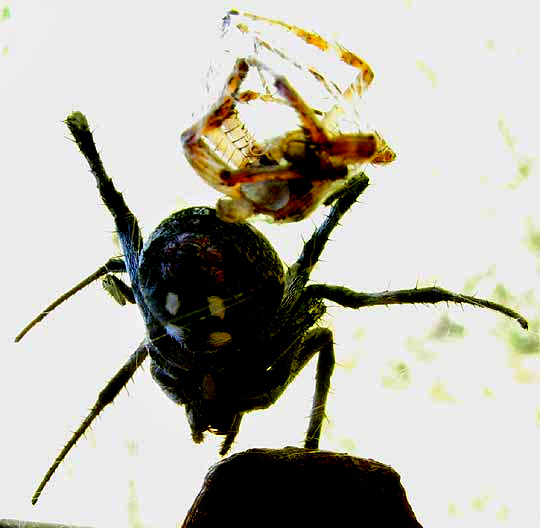
In the dazzling sunlight I couldn't see what she'd wrapped up but once the image was on the laptop screen it was clear that she'd been wrapping up an empty spider exoskeleton, probably her own. I don't believe that spiders eat their exoskeletons, so what was going on here? Whatever the case, our spider must have just shed her old "skin" so now her colors and designs were particularly vivid, as shown at the top of this page. Designs on the abdomen were especially beautiful, so I got a close-up, shown below:
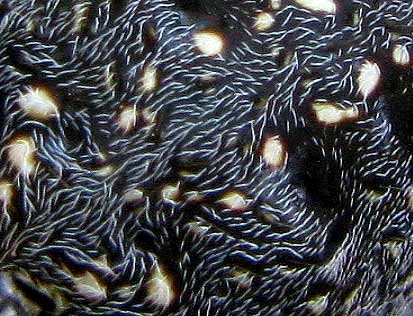
I couldn't identify the little beauty so I posted her picture at BugGuide.Net and within a couple of hours a spider fan in British Columbia said she was most likely NEOSCONA OAXACENSIS, often known as the Western Spotted Orbweaver, found throughout the warmer US states through Mexico and Central America to Peru in South America. Pictures of the species on the Internet don't perfectly match ours, but the species is known to be variable, plus, so soon after shedding, our spider's colors may not have been fully developed. Other pictures show more colorful spiders, but with fewer intricate designs on the abdomen.
Isn't it something that such delightful patterns and designs can suddenly be offered to a sweaty guy beating clods with a shovel on a dusty plot of land like this?
from the July 13, 2014 Newsletter issued from the Frio Canyon Nature Education Center in the valley of the Dry Frio River in northern Uvalde County, southwestern Texas, on the southern border of the Edwards Plateau; elevation ~1750m (~5750 ft); N29.62°, W99.86°; USA
WESTERN SPOTTED ORBWEAVER VARIATION
This week I came upon a Western Spotted Orbweaver looking very different from the one we profiled in September, 2012. Before examining it closely, though, it's worth admiring how nicely this week's spider was camouflaged in a dead flowering head of a tuft of last season's Sawgrass, as seen below:
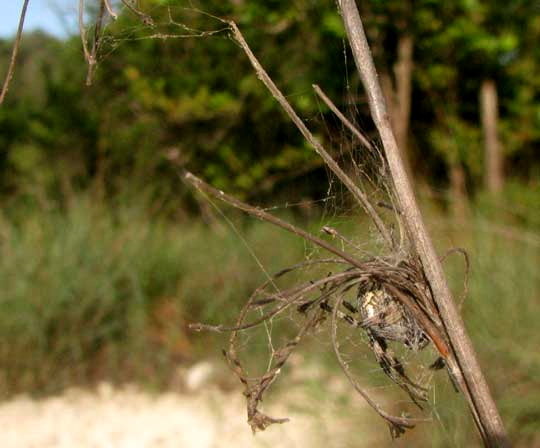
Even close up the hunkering spider could be overlooked, as you can see in a view from its side, below:
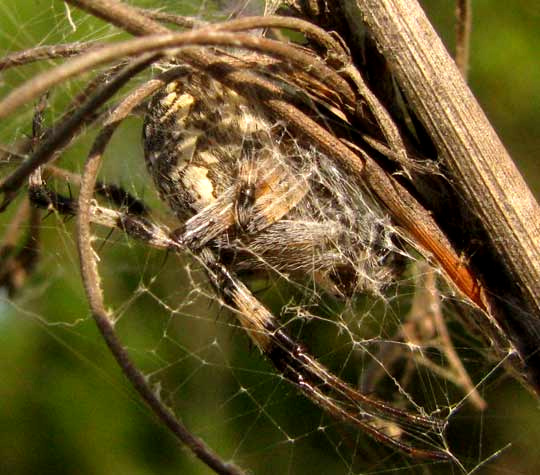
However, once the little critter has been spooked from its shelter and we have a view of the body's top, you see the abdomen's amazing arabesques, which are very different from abdomen designs of our first spider, shown below:
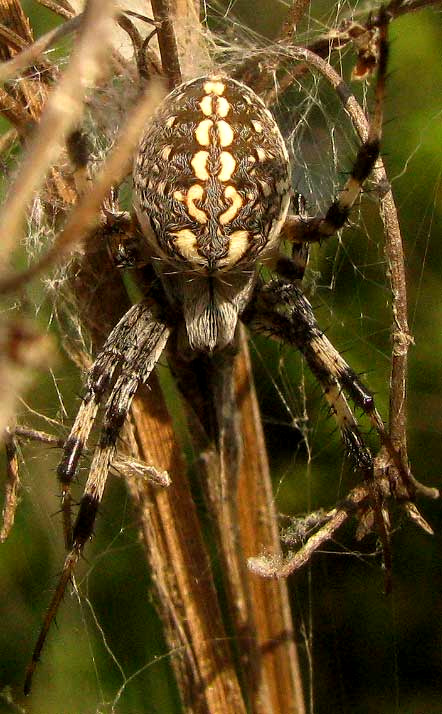
On the Internet there's plenty of talk about whether these extreme variations represent different races, or ages, or what. All I'm sure of is that the variations can occur in the same general locality.
entry dated December 13, 2022, issued from near Tequisquiapan; elevation about 1,900m, (6200 ft), ~N20.57°, ~W99.89°; Querétaro state, MÉXICO
A CENTRAL MEXICAN UPLAND VARIATION
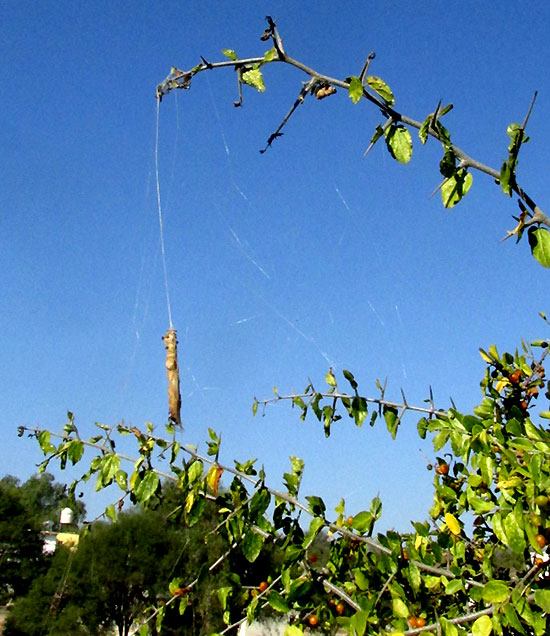
At the village's edge, at the edge of a shallow waterway, or barranca, among spiny outer branches of numerous Desert Hackberries at the waterways edge, in early morning at this season you see the remains of spiderwebs -- just a few strands running in various directions -- usually with a vertical collection of prey encased in silk, the packaged prey connected by more silk, as shown below:
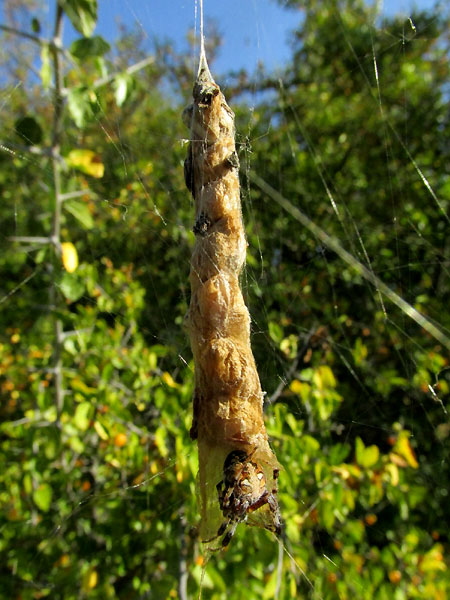
At the bottom of each such collections, the spider usually is seen somewhat camouflaged as part of the vertical assemblage, and often more snugly compacted into the silk cylinder connecting the bags than shown in the picture. Maybe 30 such spider homes occur along the barranca, averaging two or three webs per Desert Hackberry. Here's a close-up of the above spider, basking in the 9AM sunlight after a night when the season's first little frost appeared in the most exposed spots:
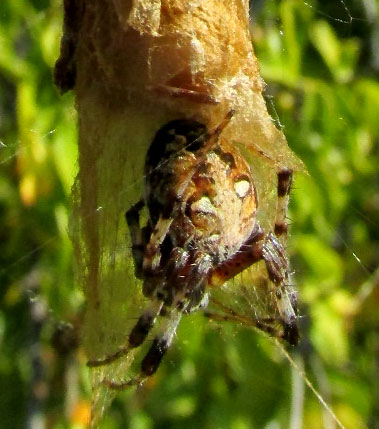
The black-and-white banding on the legs, the white-hairy covering atop the front section, the cephalothorax -- barely seen peeping from between the legs at the picture's bottom -- and the community of numerous conspicuously arrayed webs all suggested a close relationship with the garden spiders, in the spider family Araneidae. In that family the genus Neoscona displays similar tree-like patterns atop the abdomen, and in that genus, our old Texas friend the Western Spotted Orbweaver, Neoscona oaxacensis (see above entries), seemed a good bet.
That species is famously variable in appearance, so when the above spider spooked from her shelter I took more pictures to firm up the ID. Here are her bottom markings:
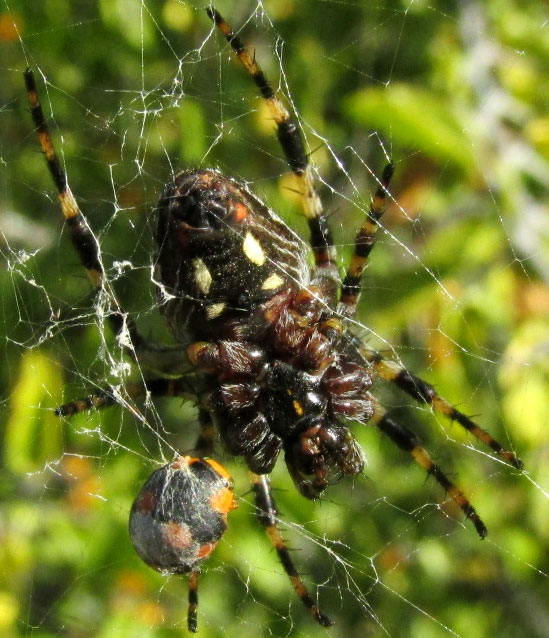
The white spots match those of our Texas spiders, despite markings on the abdomen's top being fairly different. Here's a side view of the same spider:
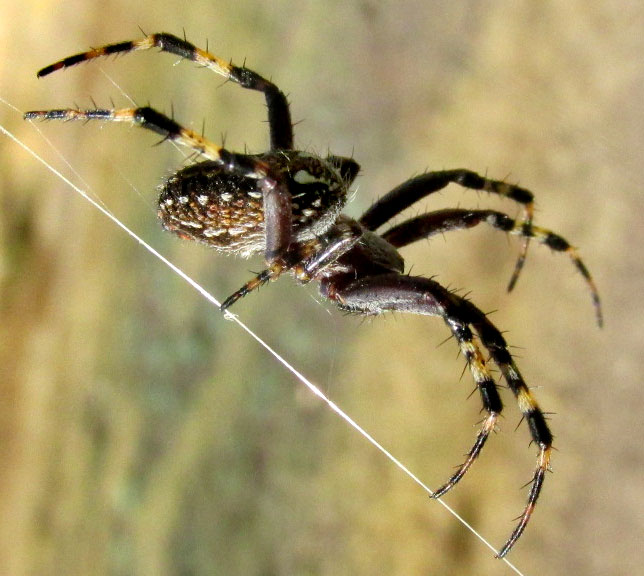
Another spider with a similar vertical line of stored prey in a different tree displayed a strikingly different pattern atop the abdomen:
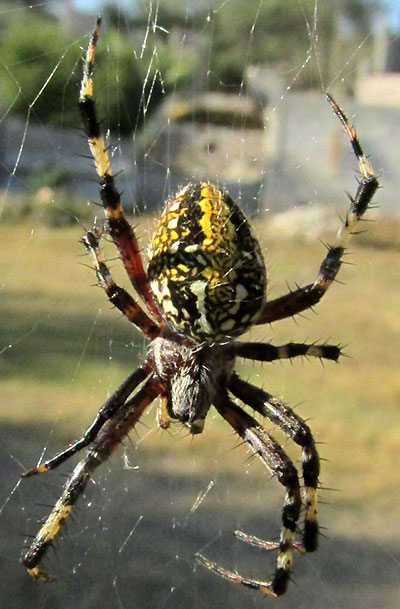
Here's a frontal view of yet a third spider:
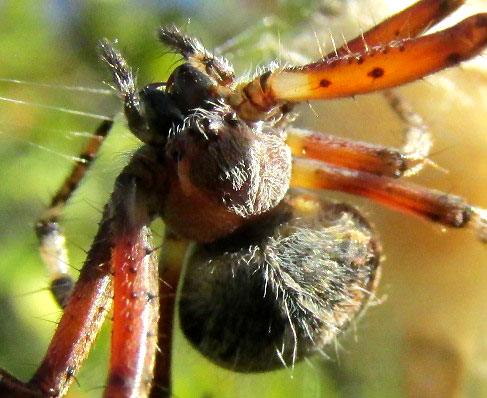
With such variability of pattern on the upper, or dorsal, abdomen I was hesitant to accept that these were Neoscona oaxacensis. However, the spots on the abdomen's lower, or ventral, side were fairly constant, and typical of the species. From the top, our first spider could be an Aculepeira packardi, but that northern species doesn't appear here, plus markings on its underside and legs are different. Other species of Neoscona have patterns atop their abdomens similar to our barranca spiders, but the spots on the underside of those species are wrong. Eventually I just had to accept that this surely is an upland, central Mexican form of Neoscona oaxacensis.
Something else about our Querétaro spiders that concerned me is that in none of the many pictures of Neoscona oaxacensis I could find on the Internet showed the vertical, silk-encased packets of prey, nor could I find mention of them in several life-history papers on the species. Yet these vertical packets were the most conspicuous feature of nearly all the webs along the barranca.
I read that Neoscona oaxacensis captures prey in its orb-type web at night, and may wrap surplus prey with silk for later consumption, but no mention is made of several such prey packages aligned in a vertical file. After a night of capturing prey, the spider eats the orb web, then rebuilds it early the next night. What I find each morning during my 9AM walk is just a few structural strands leading in various directions, along with the vertical line of prey packages.
All the vertical lines in the various webs hold about the same number of prey packets, and typically a spider shelters at the bottom of each line. None of these details appears in the literature than I can find. I wonder if perhaps this is a behavior displayed only during the days when winter temperatures may produce the first frost of the season?